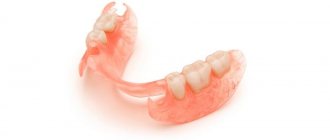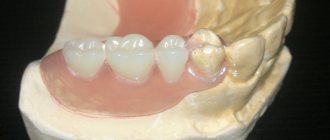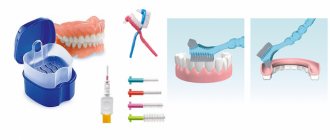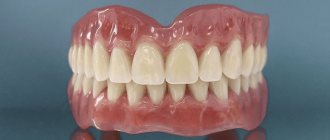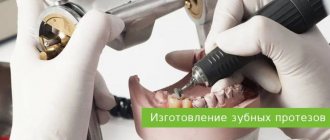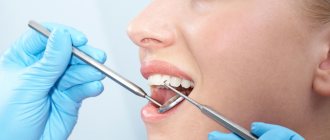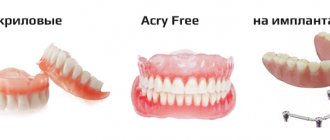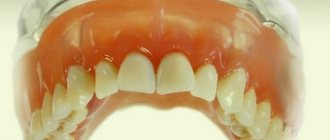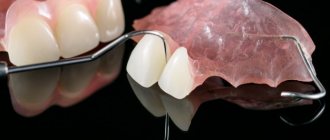Material
For the manufacture of orthodontic structures, dental nylon is used, endowed with some useful properties.
For example, it is flexible and very similar in appearance to real fabrics. Sometimes flexible nylon dentures are called “invisible”, and this is true, because they literally merge with the mucous membrane and look very realistic. And from the outside it is not at all noticeable that a person’s teeth are not “his own”, but artificial. Dental nylon has such a property as softness. This material is pleasant to the touch, despite the fact that it is a type of plastic. Ordinary plastic, from which orthodontic structures were previously made (and are still made) has a number of serious disadvantages. For example, products made from it rub the gums and are highly hard, which means that when wearing a plastic prosthesis, a person experiences not the most pleasant sensations and even discomfort. It is noteworthy that flexible nylon dentures are fixed to the supporting teeth using soft clasps.
All-on-4 design. Prostheses with bar fixation
The essence of this prosthetics is in its name. It involves the installation of a complete denture on one jaw on 4 implant supports. Implants are implanted in an inclined plane; the prosthetic process does not take much time. This prosthesis does not affect changes in taste sensations or diction.
The advantages of such a prosthesis are high aesthetics, second only to classical implantation, reliable fixation, uniform load distribution, a short period of adaptation, the ability to choose a convenient design, and no need for bone grafting.
Disadvantages: high cost compared to removable dentures; the prosthesis still feels more like a prosthesis, and not like your own teeth.
Interesting facts about dental nylon
Nylon is a thermoplastic that scientists have been studying for almost 70 years. As you know, nylon is a type of plastic that becomes highly elastic when exposed to a certain temperature. This property makes it possible to artificially recreate human organs and tissues, and research in this area is still ongoing. Over time, nylon was recognized as a safe material for the human body. And therefore it began to be actively used not only in dentistry, but also in medicine.
Americans were the first to “try on” nylon dentures. There is even a version that such orthodontic structures were created specifically for people in “extreme” professions (rescuers, police, military, firefighters, stuntmen). The professional activity of these people is associated with constant risk, and therefore dentures for them must be made of elastic materials, and nylon is most suitable for these purposes. Orthodontic products made from it are durable and not so easy to break. In Russia, prosthetics with nylon prostheses is just gaining momentum, and this know-how appeared back in 2001.
It is worth noting that both materials and technologies are constantly being improved, and now there is an incredible number of varieties of nylon used in different areas of human activity. For example, dental technicians and dentists around the world are well aware of nylon called AcryFree, which successfully combines the positive characteristics of nylon and acrylic. It is this material that is more suitable for the manufacture of complete removable dentures, since this symbiosis is ideal in all respects.
Plastic dentures –
Plastic dentures are made from acrylic plastic. These dentures can be used for both complete and partial absence of teeth. Sometimes this type of denture is also called the term “removable plate denture”. Below we will describe all the pros and cons of this prosthesis for complete and partial absence of teeth.
Acrylic prosthesis with complete absence of teeth: reviews
Fixation of complete removable dentures made of plastic (Fig. 3-6) is carried out due to the so-called “closing valve” (suction cup effect). If the prosthesis is made correctly, then after you put the prosthesis on and bite on it, excess air will come out from under the prosthesis. However, air should not get back if the contour of the prosthesis very precisely fits the tissues of the prosthetic bed and has a good fit to them.
Complete removable denture for the upper jaw: before and after photos
Complete removable denture for the lower jaw: before and after photos
Thus, a discharged space is formed under the prosthesis, which holds the prosthesis. That is why patients often call such dentures – suction cup dentures. Moreover, it is best to make complete removable acrylic dentures on an individual impression tray (remember this term), which will ensure a more precise fit of the prosthesis to the tissues of the prosthetic bed, and therefore improve its fixation.
Which prostheses are better - nylon or acrylic... when prosthetics in such a situation is done with a complete removable nylon prosthesis, there will be no “suction cup effect” due to the high elasticity of the body of the nylon prosthesis. This means that if there is a complete absence of teeth in the upper jaw, it is best to choose a plate denture made of acrylic plastic.
When replacing the lower jaw with complete absence of teeth, the fixation of the acrylic prosthesis almost always leaves much to be desired (as with nylon prostheses), and almost all patients complain of periodic loss of the prosthesis when chewing and speaking. Of course, you can also use a special cream to improve the fixation of the prosthesis, but still the most effective solution is a conditionally removable acrylic prosthesis supported by 2-3 implants (read about this type of prosthesis below).
With regard to comfort and efficiency when chewing, dentures made of plastic are superior in these qualities to dentures made of nylon, because the latter deform uncontrollably under chewing load (due to the high elasticity of nylon), causing pain when eating.
Acrylic dentures for partial absence of teeth: reviews
A partial acrylic denture will have rigid wire clasps that will extend from the plastic base of the denture and cover the supporting teeth (Fig. 7-9). It is due to them that the partial plate denture made of plastic is fixed in the oral cavity (Fig. 10-11).
Partial removable dentures for the upper and lower jaws –
Because The clasp is grasped precisely by the outer teeth (located at the edges of defects in the dentition), then if the supporting teeth are located precisely in the smile zone, the clasp will be clearly visible on the front surface of the teeth. This can only be avoided if you give preference to other types of dentures (nylon or clasp).
For a nylon denture, the clasps are made of flexible pink nylon, and therefore they are almost invisible against the background of the gums (24stoma.ru). However, the fixation of a prosthesis with elastic clasps will be, to put it mildly, “not important,” and besides, such an elastic prosthesis will also be painful to chew. And the optimal solution for partial absence of teeth will always be only prosthetics with clasp-type dentures (read about them below).
- Types of removable dentures for 1-2 teeth (Fig. 12) - when the patient is missing only 1-2 teeth in a row, if the patient is young and does not want to grind adjacent teeth into crowns or implant implants into the bone - a denture can be an alternative butterfly made of acrylic plastic.
This type of prosthesis is especially popular when it is necessary to restore one of the distant chewing teeth. A condition for good fixation of such a prosthesis will be the presence of teeth on both sides of the defect (i.e., it is impossible to prosthetize the last tooth, which has nothing behind it, with such a prosthesis). Such a prosthesis is practically invisible on the teeth.
Acrylic dentures: pros and cons
In addition to the pros and cons that we have listed above, the advantages of plastic prostheses also include: ease of manufacture, maintainability in case of breakdowns, relatively low cost - in comparison with all other types of prostheses (see cost below).
The disadvantages of plastic prostheses also include:
- dentures are quite massive and take up a lot of space in the oral cavity,
- when replacing the upper jaw (both with complete and partial absence of teeth) - the base of the prosthesis will completely cover the palate, which will cause a temporary disturbance in the articulation of speech, and will also worsen taste sensitivity due to the overlap of taste buds located on the palate,
- when making lower jaw prosthetics with complete absence of teeth, the fixation of the prosthesis will be quite poor (as with nylon prostheses), and there can only be one way out of this situation - a conditionally removable acrylic prosthesis supported by 2-3 implants.
The service life of dentures made of acrylic plastic is the recommended average service life of 3-3.5 years. However, it can be adjusted depending on the rate of jaw bone atrophy. With an increased rate of atrophy, the service life is reduced to 2.5 years; with a slow rate of bone tissue atrophy, it can increase to 5 years.
Plastic dentures: prices 2021
Prices for acrylic removable dentures are for 2022. The first figure corresponds to economy-class clinics, the second – to clinics in the middle price segment (we recorded the lowest prices in paid departments of state dental clinics).
- Complete removable acrylic denture – → in the regions – from 12,000 to 20,000 rubles. → in Moscow – from 14,000 to 20,000 rubles. (but if made from expensive materials and on an individual impression tray, then the price will be about 25,000 rubles).
- For a partial removable denture - prices in most clinics will be similar to a complete removable denture (or only slightly less, but no more than 10-15%). But a butterfly prosthesis for one tooth – the price will start from 6,500 rubles.
Advantages
- Orthodontic structures made of nylon break very rarely, which cannot be said about their acrylic counterparts, in which fracture of the bases is the main problem, occurring in 80% of cases.
- Hypoallergenic. Such products cannot cause an allergic reaction. And this is easy to prove with a simple example: after polymerization of acrylic, its composition contains up to 10% of the liquid (monomer) used to carry out this process. This substance is a strong allergen, and it can be released for five years from the date of installation of the structure. Nylon dentures do not contain monomer.
- Installation of the product does not imply grinding of the supporting teeth, that is, they are not required to be prepared.
- The absence of metal elements is a significant advantage, because they are too noticeable when talking and smiling. The nylon orthodontic structure is completely indistinguishable from real teeth.
- If the product is made correctly, it will not rub the gums and will not cause discomfort.
- Nylon has a uniform structure, which is explained by the peculiarities of its production, which means that a product made from it will fit as tightly as possible to the gum.
- Inability to color and absorb moisture are very important characteristics of the material.
- Such structures do not tend to loosen the supporting teeth, which is very important if they are affected by periodontitis. It is noteworthy that it is possible to get dentures in this way even if you have some dental diseases, and this method even allows you to strengthen your dentition, which greatly contributes to a speedy recovery.
- Reliable fixation without glue, gel and crowns, which is the merit of clasps.
- A nylon prosthesis, the price of which is affordable for almost everyone, is designed for 5-7 years of intensive use. But only if you follow all the care recommendations that a specialist from the A-Medic clinic will certainly give.
Opinions are divided!
Some patients are completely satisfied with orthodontic structures made of nylon, while others, on the contrary, tend to abandon them and give preference to acrylic analogues. Why is that? Because the Earth is full of rumors, and reviews read on the Internet and the opinions of friends who have had negative experiences wearing nylon prostheses can play a cruel joke on the patient. Where did this stereotype come from? The fact is that the first nylon structures were very soft and elastic, and at first foreign dentists used them only for temporary prosthetics, since the cost of nylon dentures was very affordable.
Their appearance in Russia greatly delighted less than honest dentists, who began recommending to their patients the installation of just such dentures, rather than acrylic ones. This “aggressive marketing” did not benefit ordinary people, since the structures lasted no more than three years, and doctors claimed that they were designed for a longer operational period.
In addition, the surface of the material, due to its softness, was poorly polished, and the orthodontic product itself was not the height of perfection and caused a lot of inconvenience when worn for a long time. All this became the reason for the emergence of stereotypes, which are helped to be broken by fundamentally new designs made from more modern and “adapted” varieties of nylon. By the way, a specialist at the A-Medic clinic can select the most suitable material for the patient.
Acrylic plastics
For decades, the primacy among structural materials has been held by polymeric (i.e., consisting of a large number of repeating units) derivatives of acrylic and methacrylic acids. They received their unique privileged position due to low toxicity, cost and ease of use: the transition from a fluid to a solid state does not require additional heating (cold polymerization polymers), which makes their use in clinical conditions possible.
Like any material, they are not without negative properties.
Among the disadvantages are:
- Surface microporosity (can cause plaque formation and discoloration);
- The presence of residual monomer - unreacted component - regardless of the manufacturing method;
- Volumetric and linear shrinkage - a decrease in size after curing due to the formation of bonds and ordering of the structure;
- Sufficient rigidity, which lengthens the period of adaptation (accustomation) to prostheses, and for some patients makes it impossible to use them without additional modification.
About the disadvantages
- Soft dentures are very easy to damage if you use regular pastes and brushes to clean them. In order for the care to be carried out correctly and not cause the product to fail and damage its appearance, you will need to take care of purchasing special liquids and brushes.
- If the material is too soft, this can lead to negative changes in bone tissue. That is, it simply atrophies, and unevenly. In addition, a loose fit of the clasps is the cause of excessive mobility of the structure, which can lead in mild cases to chafing of the mucous membrane, and in complex cases to periodontal disease.
- Dentures made of nylon, the prices of which vary, are not particularly amenable to repair and adjustment. In order to carry out the correction, the doctor requires a special “repair kit”.
- If the structure consists of nylon gums and plastic teeth, then the technician must correctly fix these two materials to each other. Otherwise, the teeth will simply come off, and at the most inopportune moment.
- Potential “carriers” of nylon dentures claim that orthodontic structures made of nylon tend to absorb odors, for example, tobacco or food.
- Pigmentation ability. One can argue with this, since much here depends on the quality of the material and its porosity. In general, staining a denture is not such a big problem, since it will still need to be professionally cleaned periodically.
- The appearance of scratches on the surface is a problem that arises due to the fault of a person who does not properly care for the product.
Expert opinion
Roman Borisovich Alekperov
orthopedic dentist
Experience: 24 years
The choice of flexible prostheses is based mainly on the patient’s desire to receive maximum comfort from wearing an orthopedic structure. Nylon or silicone prostheses do not require long-term adaptation - made from an individual cast, they immediately sit comfortably and allow you to chew food and speak normally. It is important to remember that long-term wearing of flexible prostheses can lead to the development of atrophic processes in bone tissue, since these structures do not have a rigid base. Do not use flexible dentures for more than 6-9 months if you are planning to have implants. If such a situation occurs and the bone is “gone,” it will be necessary to pre-build it or perform basal implantation.
Varieties
If several teeth are missing from the dentition, a partial nylon denture can solve this problem. If only one tooth is missing, then the deficiency can well be compensated by a “single” prosthesis made of nylon, for the fixation of which you will not have to grind down the adjacent teeth, since the structure is fixed to them using clasps. “Butterfly” is a nylon prosthesis, which received such a poetic name due to the peculiarities of fixation to the supporting teeth, and is intended to replace one missing dental unit. Clasps really resemble butterfly wings.
In case of complete edentia, a complete removable nylon denture is used, and if previously it was not very popular due to the high softness of the material, now the popularity of such a product is only gaining momentum, and perhaps it will soon supplant its counterpart made of rough plastic. Although, some experts are not sure about this. It remains to add that the color of the material is selected individually.
Kinds
Among the variety of prostheses, they are divided into:
- partially removable;
- completely removable structures;
- conditionally removable.
Fully removable systems are most often used for complete tooth loss. They are created from individual casts, taking into account all the anatomical features and structure of the patient’s jaw.
They are made to be as comfortable as possible and the recommendation is not to take them off at all for the first time. During the test period of wear, the body gets used to it, and the doctor monitors the patient’s reaction to the prosthetics.
If necessary, the dentist makes adjustments and adjusts the design of the prosthesis, which makes wearing them more comfortable and painless. This type of removable denture looks very natural. They are made from the following materials: nylon, plastic. Please note that the structures are non-toxic and do not cause harm to health.
Conditionally removable dentures are recommended for the loss of one tooth. Such medical systems do not need to be removed before going to bed. They are attached to adjacent teeth using special cement; metal hooks and glue are also used for fastening.
Partially removable types of structures are not the most convenient. They attach to the gums and take up a lot of space in the mouth. This option is suitable for permanent wear, on a temporary basis and can replace one or more teeth. The technology is not perfect, but its financial accessibility makes it popular today.
Consequences of long-term wearing
Nylon prostheses tend to gradually deform during use. The fact is that the frame is not rigid, but flexible, and accordingly, it is not able to distribute the load evenly. It is noteworthy that the maximum pressure occurs on the most “active” part of the orthodontic structure. For this reason, a person may experience discomfort while eating, and bone tissue atrophies faster. But that’s not all: the chewing load falls not only on the middle part of the gum, but also on the marginal part. This can negatively affect periodontal tissue. If the patient is not afraid of the possible consequences of wearing such structures, then he can safely contact the specialists of the A-Medic clinic.
Recommendations
According to this policy document, at present, due to the limited scope of application, non-rigid prostheses with non-metallic clasps cannot be recommended as permanent prostheses in accordance with modern orthopedic principles, with the exception of patients with metal allergies and some others. Prostheses with non-metallic clasps with a metal frame to provide rigidity can be recommended in cases where the patient does not like the location of the metal clasp in the aesthetic area. Relocation and repair methods should be selected taking into account the properties of the various materials used.
Conflict of interest
The preparation of this policy document was funded by the Japan Orthopedic Society. JPS does not receive endorsement from any specific group or corporation. There was no funding from any group or corporation in the preparation of this policy document. The panelists and clinical guidelines committee members involved in the preparation of this policy document did not receive any assistance from a specific group or corporation associated with PNMK. Panel members who contributed to the development or reported on a particular plastic were not involved in the description of that plastic.
Statement
This article is a republication of a policy paper published in the Annals of Japan Prosthodontic Society [27].
Indications for installation
- For children and adults, if the nylon prosthesis is removable, it should take on the function of a temporary orthodontic structure.
- Patients with periodontal disease are not prohibited from wearing these devices to restore the integrity of the dentition, but are recommended.
- Children who have lost their baby teeth early due to injury, advanced caries, etc.
- Patients with malocclusion and problems with the dental system.
- Persons engaged in a potentially dangerous type of professional activity, for whom it is extremely undesirable to wear plastic and metal prostheses.
- Nylon removable dentures are indispensable assistants during dental implantation, when a permanent dental crown cannot be immediately placed on the pin.
- People who have a “deficiency” of 1-5 dental units.
- Patients with diseases of the cardiovascular and endocrine systems.
- If you are allergic to other materials.
- If for some reason the patient cannot grind his abutment teeth.
Indications and contraindications
Indications for installation are the loss of teeth (one, several or all), especially if the patient cannot have implants installed. But there are also contraindications:
- periodontal disease grades 3 and 4, in which the tissue around the tooth is completely destroyed,
- low crown height of abutment teeth,
- inflammatory process of the mucous membranes or gums,
- high gum mobility,
- significant bone tissue atrophy,
- Recession is the receding or overgrowth of the gums.
Manufacturing and installation
A person who decides to install soft nylon dentures must first come to the A-Medic clinic so that the doctor determines the feasibility of installing them. If there are no obstacles to the implementation of the plan: there are no contraindications, and the gums and the oral cavity as a whole are in good condition, then prosthetics are possible. In the presence of inflammation and carious teeth, the process is postponed until these problems are eliminated. That is, the patient must undergo oral sanitation.
If everything is in order, the doctor makes impressions of the jaw, which are sent to the laboratory, where specialists will make a plaster model of it. Initially, the orthodontic structure is made of liquid wax, and it is this that is involved in the first fitting. The production of nylon prostheses begins only when the doctor is completely convinced that the wax copy “fits like a glove” and there are no complaints about it. This product is cast in a heat press, after which it is installed in its place. Any specialist involved in dental prosthetics must tell the patient about all the intricacies and difficulties of caring for an orthodontic structure.
Preparation of a policy document
The 21 participants selected to serve on the expert committee for 2011-2012 were asked to fill out a questionnaire; Five participants with experience with thermoplastic resin partial dentures on multiple patients were included in our expert panel. Information was then collected from JPS members with at least 5 years of clinical experience with thermoplastic removable partial dentures, and an additional 9 participants were selected to serve on the expert panel. Thus, a total of 14 participants prepared the initial draft of this document. At a group meeting in August 2012, members discussed the official name and definition for thermoplastic resin partial dentures and the structure of the policy document and reached consensus. All panelists were responsible for writing the various sections of the draft document, and the content was revised through online discussion by the group as a whole until a consensus was reached. The final document was finalized after review by the Clinical Guidelines Committee. PubMed and ICHUSHI online databases were used to search the literature in the same manner as a manual search. The literature selection was not carried out systematically.
Rules of care and wearing features
- Some people wear removable nylon dentures constantly, removing them only from time to time, which in itself is wrong, since the structure must be removed and washed with a stream of water after each meal. If this is not possible, then you need to at least rinse your mouth.
- Cleaning of the prosthesis is carried out twice a day, and special means and devices are used for these purposes. Of course, the patient should regularly brush his “real” teeth and rinse his mouth after every meal.
- If there is no special cleaning liquid, then regular toilet soap can be an alternative, but not toothpaste, and the brush should be very soft. At least twice a year, a nylon flexible prosthesis should be professionally cleaned, for which you just need to come to the A-Medic clinic.
- If for some reason the structure is not used for a long time, then in order to prevent drying out, it should be placed in a glass of water.
- After installing the product, you should not eat rough food for a while. And in order to quickly get used to the “foreign body” in your mouth, doctors recommend talking and reading aloud more.
- If discomfort occurs while wearing the structure, then you need to tell your dentist about all your feelings.
- It is not recommended to drop a soft dental prosthesis, and in order for it to last longer, it must be handled very carefully.
Advantages of nylon as a material for removable dentures
- Lack of so-called residual monomer - a substance that forms the basis of plastic powder and causes local allergic reactions (redness, swelling, itching of the mucous membrane of the prosthetic bed) or even systemic in some patients;
- Biocompatibility (this is important for patients with diseases of the immune, endocrine, nervous systems, and gastrointestinal tract);
- The ability to withstand enormous loads when falling, hitting or bending while maintaining the original shape (elastic deformability - elasticity) - even if you drop the prosthesis on a tiled floor, nothing will happen to it;
- Lightness and grace, subtlety;
- Strength (the ability of the prosthesis to withstand chewing pressure without destruction);
- Greater aesthetics compared to acrylic dentures (“naturalness”);
- Subjectively, for patients - greater ease of use, both during primary and repeated prosthetics (comfort, quick adaptation and invisibility to others) - “soft dentures”.
Nylon or acrylic?
There is still ongoing debate among dentists and their patients about which material is better. Nylon dentures have been used in dentistry not so long ago, unlike acrylic ones, and often a person doubts and does not know what to prefer: time-tested acrylic or innovative nylon. For this reason, you need to know for sure in what situations a certain material will be more suitable:
- If this is a single prosthetic procedure, then it is recommended to close the “hole” in the dentition using an orthodontic product made of nylon. Dental prosthetics with nylon dentures is also recommended in cases where 2-3 dental units in a row are missing.
- If more than half of the teeth are missing in the oral cavity, then the choice of dental prosthetics method largely depends on the location of the “gaping voids”. It may be easier for a person to install implants than soft dentures. It is noteworthy that some dentists trust acrylic products more, since they are more widespread and familiar than their “innovative counterparts.”
- If orthodontic structures made of acrylic are installed in the oral cavity, then you can be sure that the load on them is distributed evenly.
- Nylon complete removable dentures are products to which their “wearer” gets used to very quickly. Acrylic analogues cannot boast of this.
- Both materials have advantages and disadvantages, and often the patient's choice is determined by price.
Clasp structures supported by implants
Due to the fact that clasp prosthetics requires support, in the case of complete edentia, the clasp can be installed only after implantation. Thanks to the metal frame in the form of an arc, strength and uniform distribution of the load when chewing are ensured. Artificial teeth and a plastic base that imitates gums are attached to the frame. There are several types of fastening: hooks, clasps and crowns.
The “All-on-4x” design is also a variant of the clasp on implants.
How much does a nylon prosthesis cost?
Each clinic providing dental services and dental prosthetics has its own pricing policy. Nylon flexible prostheses, the price of which may please some and upset others, are becoming more popular day by day. But before installing them, it is recommended that you familiarize yourself with the prices, because each dental clinic has their own. The final cost of dentures depends on various factors.
For example, on the condition of the oral cavity, on the number of missing teeth, on the location of the clinic and its reputation. The skill of a specialist plays an important role in pricing, and the higher the professional rating, the more expensive the doctor’s services. In any case, the installation of such orthodontic structures will cost much less than implantation and prosthetics with zirconium crowns.
Nylon dentures, the cost of which is affordable, for many people are the only opportunity to fill gaps in the dentition, and without significant financial expenses.
It is worth noting the fact that structures are not always fixed using soft clasps, since they can be metal. This is a cost-reducing factor, but the fact is that metal clasps are too noticeable and there can be no talk of any aesthetics. Therefore, before giving them preference, you should think carefully: is such saving necessary that it worsens aesthetic characteristics? There is an opinion that “hard fixation” is more reliable, but in fact, this assumption is not true, since soft clasps also perform their task well.
Indications for use
As a rule, complete removable dentures are indicated for defects in a number of teeth, such as complete loss of chewing teeth. In addition, the pathological condition of the periodontium may be an indication. Severe periodontitis requires the installation of such structures; this will be the best solution for patients with this disease. The choice of the type of prosthesis depends on the specific case; the decision is made by the doctor together with the patient, based on a thorough examination of the oral cavity.
Conditions for installing the Quadrotti clasp prosthesis
To install the prosthesis and securely fix it in the oral cavity, at least four supporting teeth in a row are required. This is perhaps the main condition for prosthetics using this method. Abutment teeth do not require grinding or other processing, which is important for their further functioning. Unfortunately, it is impossible to use an implanted tooth as a support. A nylon removable denture is installed on a jaw with complete edentia (no teeth), but in terms of reliability of fixation it is inferior to a clasp denture.

